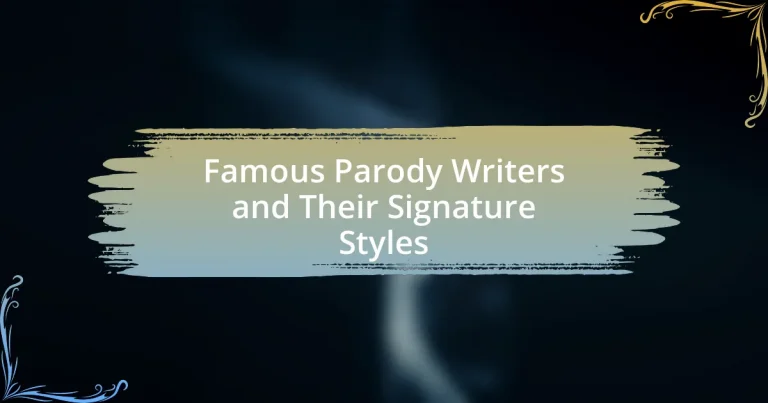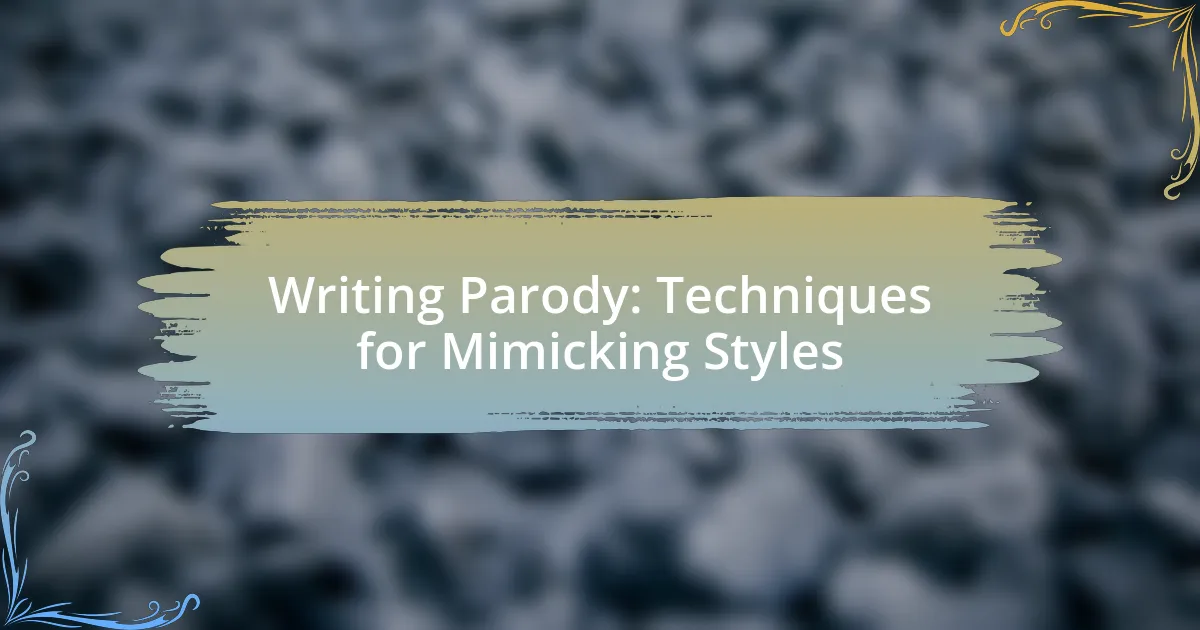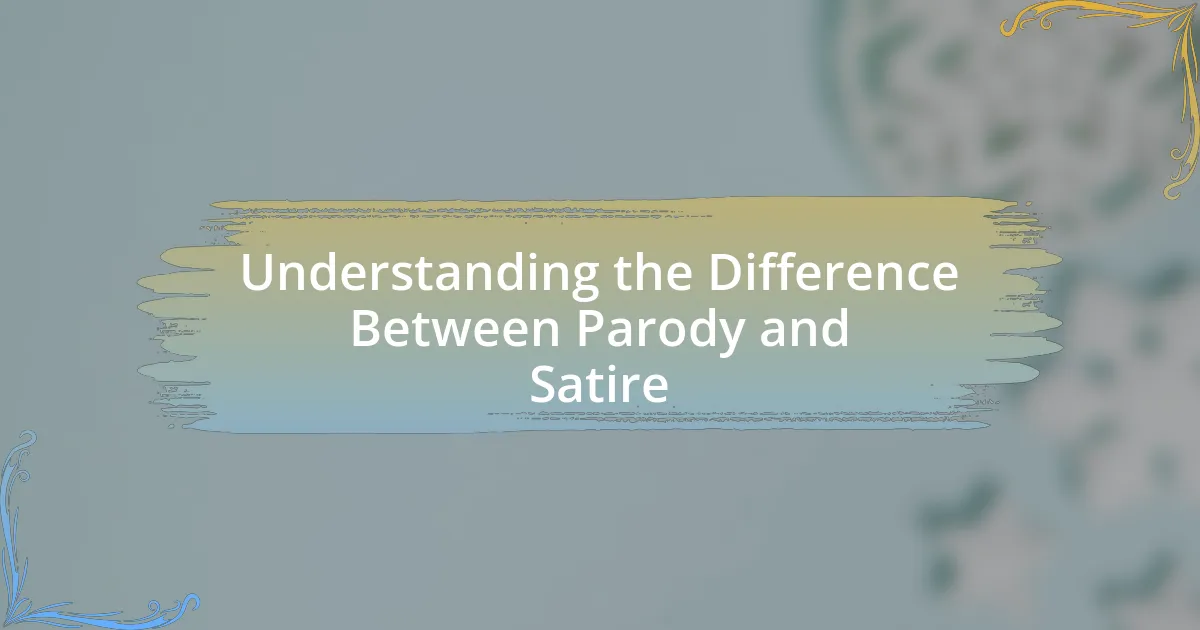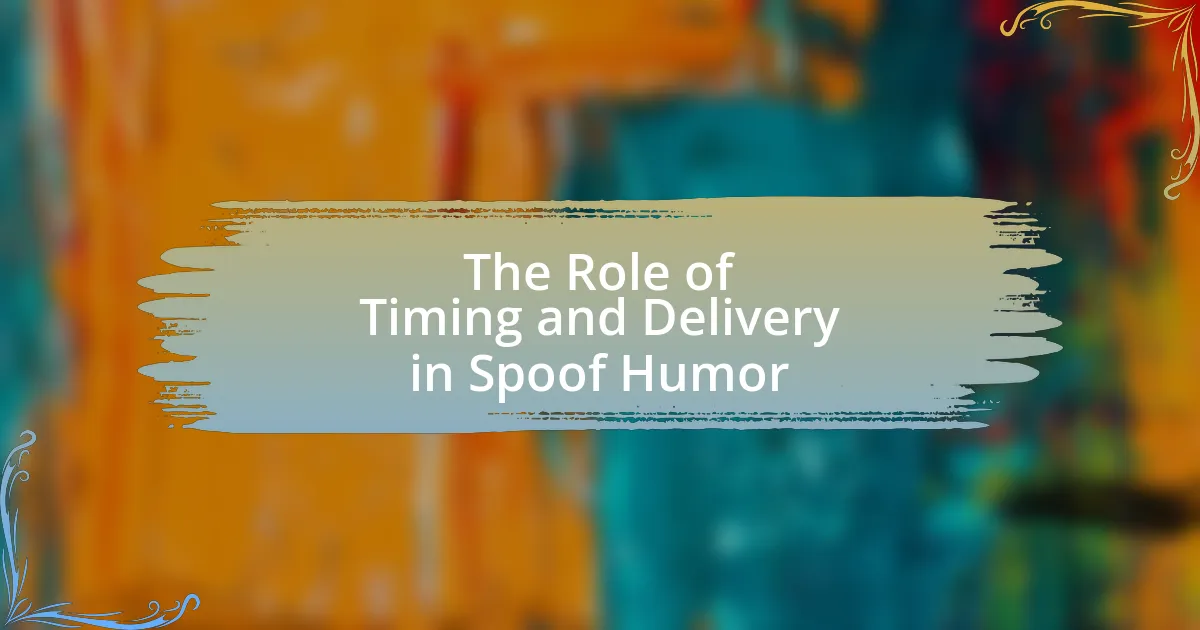The article focuses on famous parody writers and their signature styles, highlighting notable figures such as Jonathan Swift, Mark Twain, and Douglas Adams. It examines the defining characteristics of their works, including humor, satire, and exaggeration, and discusses how these elements differentiate them from other writers. The article also explores common themes in their parodies, their influence on the genre, and their impact on popular culture. Additionally, it addresses the evolution of parody styles over time and provides insights into techniques aspiring writers can adopt while avoiding common pitfalls in parody writing.
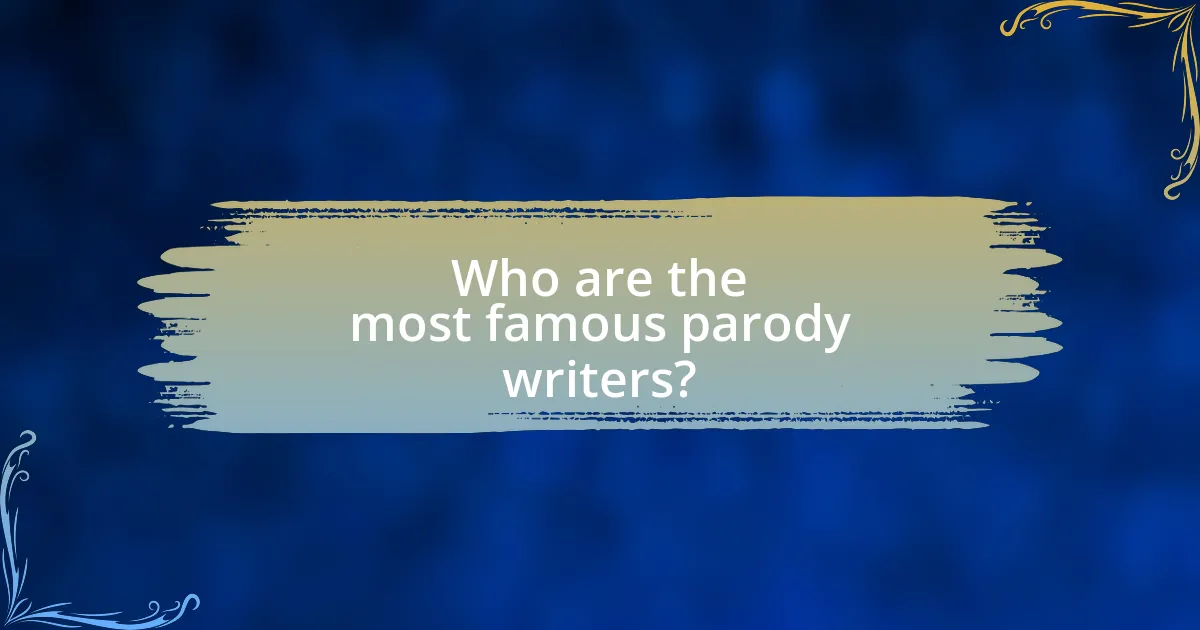
Who are the most famous parody writers?
The most famous parody writers include Jonathan Swift, known for “A Modest Proposal,” and Mark Twain, recognized for his satirical works like “The Adventures of Huckleberry Finn.” Additionally, Douglas Adams gained fame with “The Hitchhiker’s Guide to the Galaxy,” which parodies science fiction tropes. Furthermore, the television show “Saturday Night Live” has featured numerous writers, such as Tina Fey and Seth Meyers, who have created iconic parodies of political figures and pop culture. These writers are celebrated for their ability to blend humor with social commentary, making their works both entertaining and thought-provoking.
What are the defining characteristics of their works?
The defining characteristics of the works of famous parody writers include humor, satire, and exaggeration. These writers often employ wit to critique societal norms, cultural phenomena, or literary conventions. For instance, Jonathan Swift’s “A Modest Proposal” uses irony to address serious social issues, while parodic elements in works like “The Onion” or “Saturday Night Live” highlight absurdities in current events and popular culture. The effectiveness of their parody lies in the ability to blend entertainment with commentary, making their critiques both accessible and thought-provoking.
How do these characteristics differentiate them from other writers?
Famous parody writers differentiate themselves through their unique blend of humor, satire, and cultural critique. These characteristics allow them to create works that not only entertain but also provoke thought about societal norms and conventions. For instance, writers like Douglas Adams and Terry Pratchett employ absurdity and wit to highlight the flaws in human behavior and societal structures, setting them apart from traditional authors who may focus solely on narrative or character development. Their ability to mimic and exaggerate existing genres or styles, as seen in works like “The Hitchhiker’s Guide to the Galaxy,” showcases a distinctive approach that combines parody with insightful commentary, making their contributions to literature both entertaining and intellectually stimulating.
What themes are commonly explored in their parodies?
Common themes explored in parodies include societal norms, popular culture, and political satire. Parody writers often use humor to critique and exaggerate these themes, highlighting absurdities in everyday life and current events. For instance, works by authors like Jonathan Swift and modern comedians often reflect on the follies of human behavior and the contradictions within societal expectations, making their critiques both entertaining and thought-provoking.
How have these writers influenced the genre of parody?
Writers such as Jonathan Swift, Mark Twain, and Douglas Adams have significantly influenced the genre of parody by employing satire to critique societal norms and literary conventions. Jonathan Swift’s “A Modest Proposal” exemplifies how parody can address serious issues through absurdity, while Mark Twain’s “The Adventures of Huckleberry Finn” parodies romantic literature and societal values, exposing their flaws. Douglas Adams’ “The Hitchhiker’s Guide to the Galaxy” uses humor and absurdity to parody science fiction tropes, reshaping reader expectations. These writers have established parody as a powerful tool for social commentary, demonstrating its ability to provoke thought while entertaining audiences.
What impact have they had on popular culture?
Famous parody writers have significantly influenced popular culture by shaping humor, satire, and social commentary across various media. Their works often challenge societal norms and provide critical insights into contemporary issues, making them relevant and impactful. For instance, writers like Jonathan Swift and more modern figures such as “Weird Al” Yankovic have used parody to critique politics and pop culture, thereby engaging audiences in discussions about these topics. The widespread appeal of their parodies has led to a greater acceptance of satire in mainstream entertainment, as seen in television shows like “Saturday Night Live” and “The Simpsons,” which regularly incorporate parody to comment on current events and cultural phenomena.
How have their styles evolved over time?
Famous parody writers have evolved their styles over time by adapting to cultural shifts and technological advancements. For instance, early parody writers like Jonathan Swift utilized satire to critique societal norms, while modern writers such as The Onion and Saturday Night Live incorporate multimedia elements and internet culture to engage audiences. This evolution reflects a shift from traditional literary forms to more dynamic, accessible formats that resonate with contemporary audiences, demonstrating how parody adapts to maintain relevance in changing contexts.
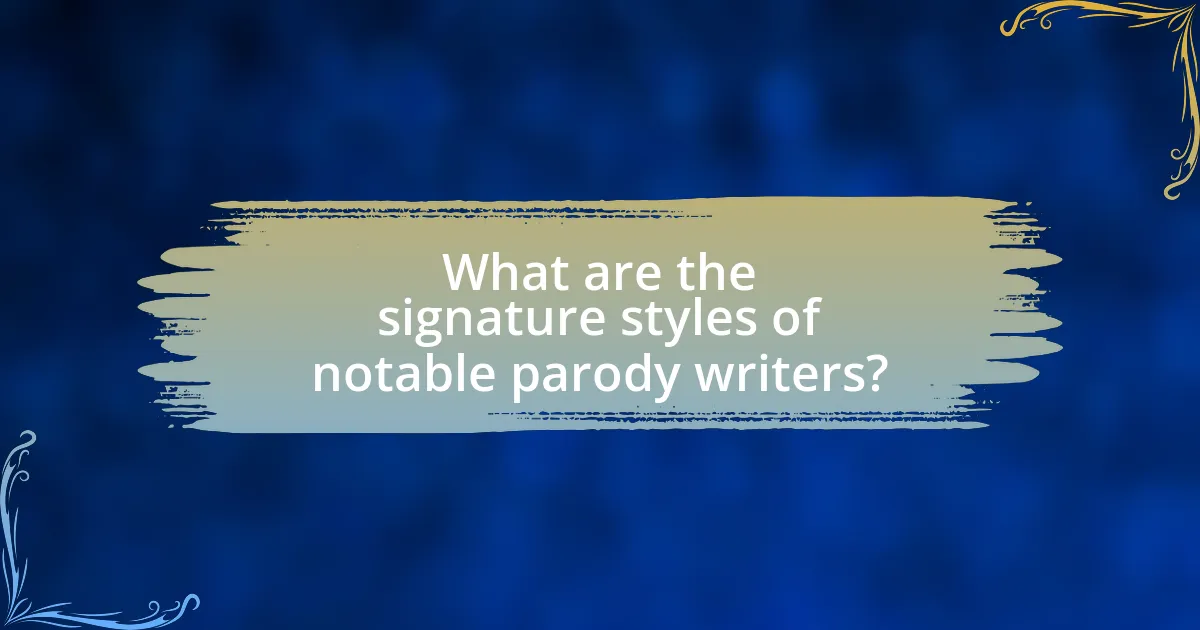
What are the signature styles of notable parody writers?
Notable parody writers exhibit distinct signature styles characterized by their unique approaches to humor and satire. For instance, Jonathan Swift is known for his use of irony and exaggeration, particularly in “A Modest Proposal,” where he critiques societal issues through shocking suggestions. Similarly, Mark Twain employs regional dialects and wit to parody social norms and human behavior, as seen in “The Adventures of Huckleberry Finn.” Additionally, Douglas Adams utilizes absurdity and clever wordplay in “The Hitchhiker’s Guide to the Galaxy,” creating a comedic yet thought-provoking narrative. These styles are effective in highlighting the flaws and absurdities of their subjects, making their parodies both entertaining and insightful.
How does each writer’s style reflect their unique voice?
Each writer’s style reflects their unique voice through distinct techniques, thematic choices, and linguistic patterns. For instance, Mark Twain employs regional dialects and humor to convey authenticity and social critique, while Douglas Adams uses absurdity and wit to create a satirical commentary on life and technology. These stylistic choices not only differentiate their works but also enhance their individual perspectives, making their voices recognizable and impactful in the realm of parody.
What techniques do they use to create humor?
Famous parody writers use techniques such as exaggeration, satire, and incongruity to create humor. Exaggeration amplifies characteristics or situations to absurd levels, making them comical; for instance, in “The Onion,” headlines often take real news and blow them out of proportion. Satire critiques societal norms or behaviors through humor, as seen in “Saturday Night Live,” which often mocks political figures and current events. Incongruity involves presenting unexpected twists or contrasts, which can be observed in works by writers like Douglas Adams, where ordinary situations are placed in bizarre contexts, leading to humorous outcomes. These techniques are effective because they resonate with audiences by highlighting the absurdities of life and society.
How do they incorporate satire into their work?
Famous parody writers incorporate satire into their work by using humor to critique societal norms, politics, and cultural phenomena. For example, writers like Jonathan Swift in “A Modest Proposal” employed exaggerated scenarios to highlight the dire conditions of the poor in Ireland, effectively using irony to provoke thought and discussion. Similarly, modern parody writers often mimic the style of their subjects, creating a juxtaposition that emphasizes the absurdity of the original material, as seen in works like “The Onion” or “Saturday Night Live,” which satirize current events and public figures through comedic sketches and articles. This method not only entertains but also encourages audiences to reflect critically on the issues being addressed.
What are some examples of their most famous works?
Famous parody writers include Jonathan Swift, whose notable work “A Modest Proposal” satirizes British policy towards the Irish, and Mark Twain, recognized for “The Adventures of Huckleberry Finn,” which parodies societal norms and racism. Additionally, Douglas Adams is known for “The Hitchhiker’s Guide to the Galaxy,” a comedic take on science fiction tropes. These works exemplify the authors’ ability to critique society through humor and satire, reinforcing their status in literary history.
How do these works exemplify their signature styles?
Famous parody writers exemplify their signature styles through distinctive techniques that highlight humor, satire, and cultural critique. For instance, writers like Douglas Adams utilize absurdity and wit to create a unique narrative voice, as seen in “The Hitchhiker’s Guide to the Galaxy,” where the interplay of science fiction and comedy showcases his ability to blend genres. Similarly, Jonathan Swift’s “A Modest Proposal” employs irony and hyperbole to critique social issues, effectively demonstrating his sharp satirical style. These works not only reflect the individual writer’s voice but also serve as a commentary on societal norms, reinforcing their signature approaches to parody.
What critical reception have these works received?
The works of famous parody writers have generally received positive critical reception, often praised for their wit and cleverness. For instance, the parodies of authors like Douglas Adams and P.G. Wodehouse have been lauded for their unique ability to blend humor with insightful commentary on society and literature. Critics frequently highlight how these writers effectively use satire to engage readers while providing a humorous critique of their subjects. This acclaim is supported by numerous literary reviews and analyses that emphasize the enduring popularity and influence of their works in both literary and popular culture.
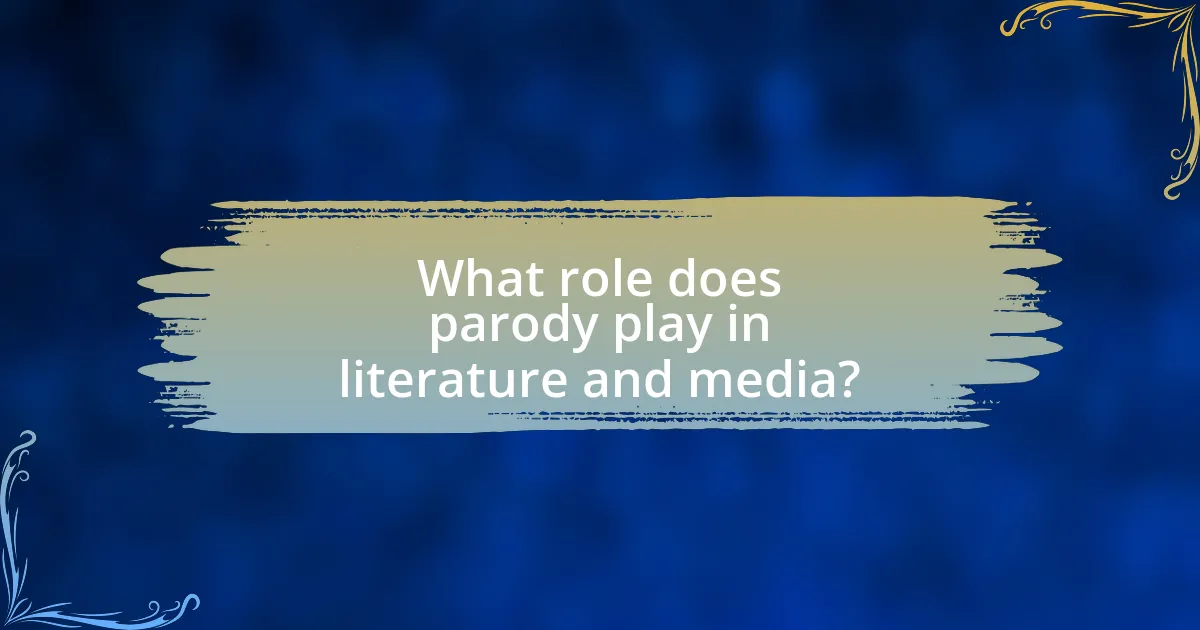
What role does parody play in literature and media?
Parody serves as a critical tool in literature and media by providing commentary on societal norms, cultural phenomena, and established genres. It allows creators to mimic and exaggerate the characteristics of their subjects, often highlighting absurdities and inconsistencies within them. For instance, works like “Don Quixote” by Miguel de Cervantes and “The Onion” in modern media exemplify how parody can challenge prevailing narratives and provoke thought. By employing humor and satire, parody not only entertains but also encourages audiences to reflect on the original material, making it a significant vehicle for social critique and artistic expression.
Why is parody an important literary device?
Parody is an important literary device because it allows writers to critique and comment on societal norms, cultural phenomena, and other literary works through humor and exaggeration. By mimicking the style of the original work, parody highlights its flaws and absurdities, making it a powerful tool for social commentary. For instance, works like “Don Quixote” by Miguel de Cervantes and “The Onion” in modern media utilize parody to expose the ridiculousness of their subjects, thereby engaging readers in critical reflection. This dual function of entertainment and critique underscores the significance of parody in literature.
How does parody contribute to social commentary?
Parody contributes to social commentary by using humor and exaggeration to critique societal norms, behaviors, and institutions. This form of satire allows writers to highlight absurdities and contradictions within culture, making complex issues more accessible and engaging for audiences. For instance, the works of Jonathan Swift, particularly “A Modest Proposal,” exemplify how parody can provoke thought and discussion about serious social issues like poverty and inequality through ironic and shocking suggestions. By distorting reality, parody encourages audiences to reflect on the status quo and consider alternative perspectives, thereby fostering critical dialogue about societal values and practices.
What are the risks and rewards of using parody?
Using parody carries both risks and rewards. The primary reward of using parody is its ability to provide social commentary and critique, often making complex issues more accessible and engaging for audiences. For instance, works like “The Onion” and “Saturday Night Live” effectively use parody to highlight societal flaws, which can lead to increased awareness and discussion. Conversely, the risks include potential legal repercussions, such as copyright infringement or defamation claims, as seen in cases like “Campbell v. Acuff-Rose Music, Inc.,” where the court ruled on the limits of fair use in parody. Additionally, parody can alienate audiences if the humor is misinterpreted or deemed offensive, which may damage the creator’s reputation. Thus, while parody can be a powerful tool for expression and critique, it must be navigated carefully to avoid legal and social pitfalls.
How can aspiring writers develop their own parody style?
Aspiring writers can develop their own parody style by studying existing parodists and practicing their craft through imitation and innovation. Analyzing the techniques of famous parody writers, such as the use of exaggeration, satire, and humor, allows writers to understand the mechanics of parody. For instance, writers like Douglas Adams and P.G. Wodehouse have distinct styles that blend wit with social commentary, providing a framework for new writers to explore. Additionally, consistent writing practice, feedback from peers, and experimenting with different subjects can help refine a unique voice in parody.
What techniques can they learn from famous parody writers?
Famous parody writers employ several techniques that can be learned, including exaggeration, satire, and intertextuality. Exaggeration amplifies characteristics or situations to absurd levels, making the parody more humorous and impactful, as seen in the works of writers like Charles Addams. Satire critiques societal norms and behaviors, often using irony and wit, which is a hallmark of writers like Jonathan Swift. Intertextuality involves referencing or recontextualizing existing texts, allowing for deeper commentary and humor, a technique effectively used by authors such as parodist Douglas Adams. These techniques not only enhance comedic effect but also provide critical insights into the subjects being parodied.
What common pitfalls should they avoid in parody writing?
Common pitfalls to avoid in parody writing include failing to understand the source material, which can lead to ineffective humor and misrepresentation. Parody relies on a deep comprehension of the original work to create a humorous or critical commentary; without this understanding, the parody may fall flat or confuse the audience. Additionally, excessive reliance on clichés can diminish originality and impact, as seen in many parodies that recycle tired jokes rather than offering fresh perspectives. Furthermore, neglecting character development or plot coherence can result in a parody that lacks substance, making it less engaging. Lastly, being overly harsh or mean-spirited can alienate audiences, as successful parodies often balance critique with affection for the original work.
